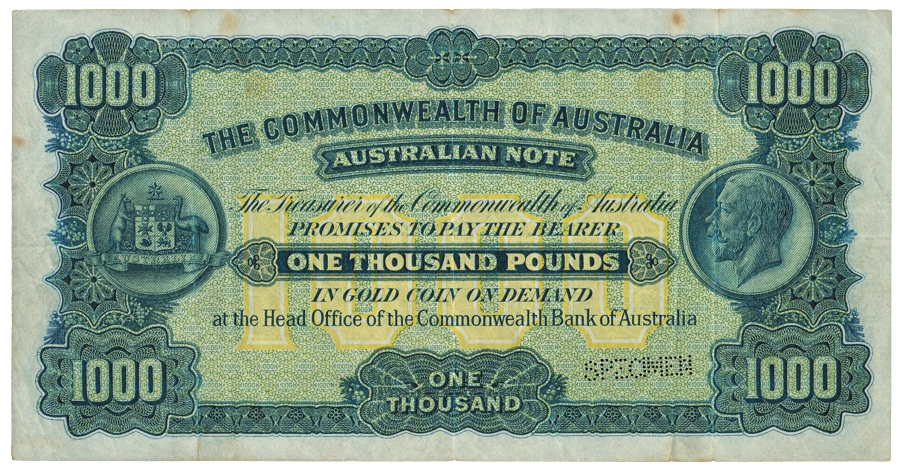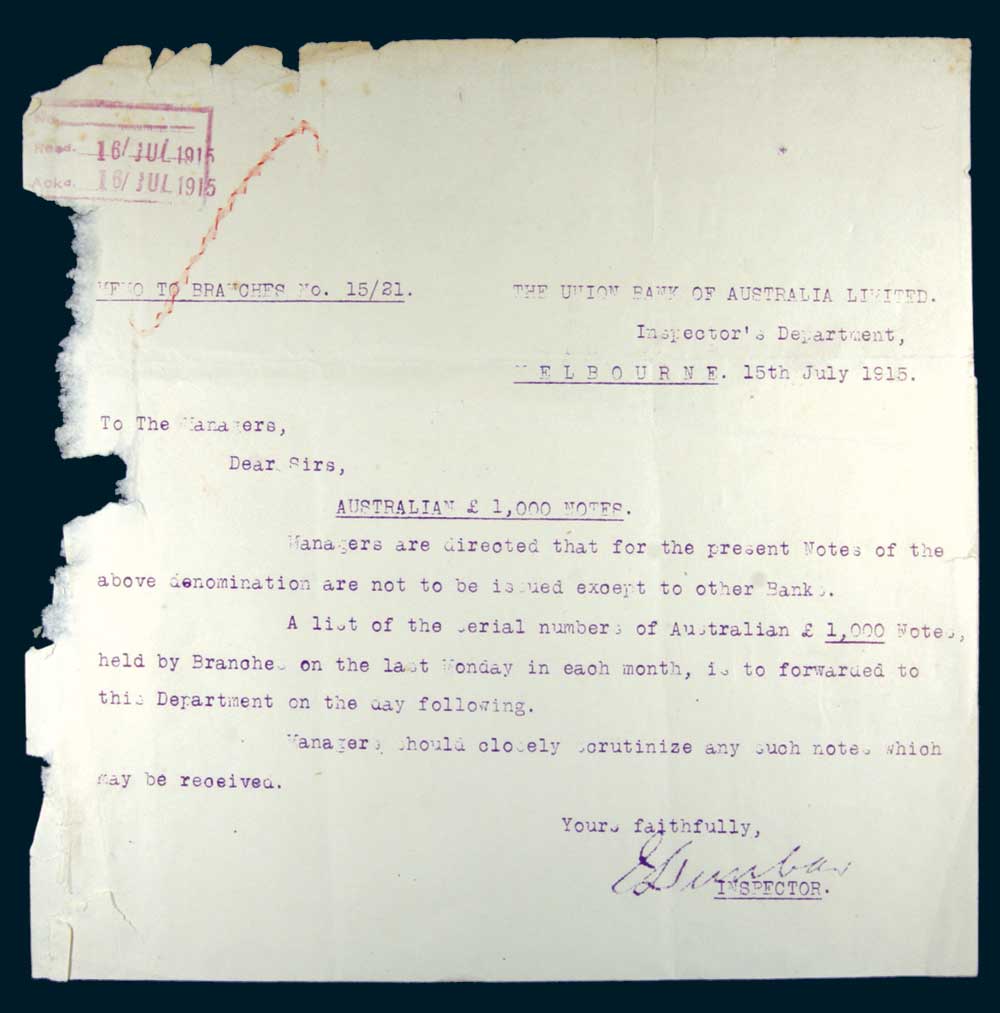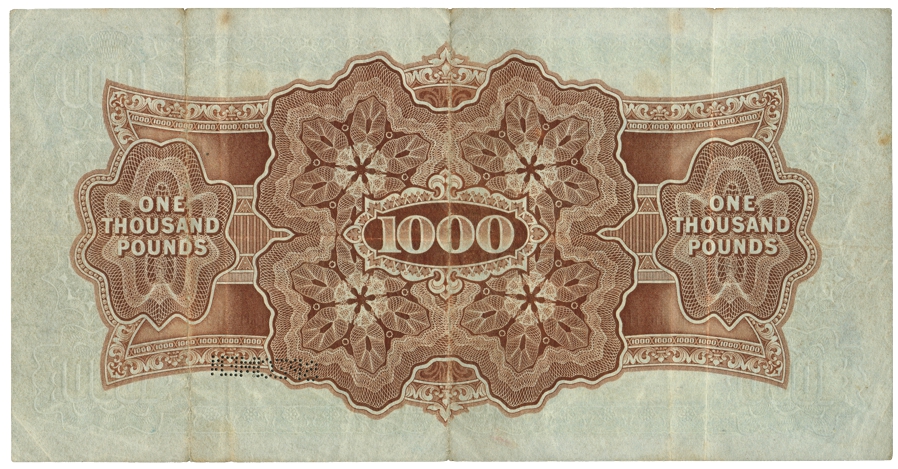The Type Two Unissued £1,000 Specimen Note - A Legacy of Australia’s Transition to Central Reserve Bank

The Unissued Type Two One Thousand Pound Specimen note is one of Australia’s most important currency notes - it is by far the highest denomination in the Australian monetary system, it is unique in private hands, it may well have a provenance linking it to Australia’s transition to central reserve banking, and easily ranks among Australia’s most valuable numismatic items.

In February 2014, the Unissued Type Two One Thousand Pound Specimen note will be offered for sale by Roxbury’s Auction Galleries in Brisbane - for a dedicated numismatist with a keen interest in Australian banknotes, this event may prove to be a once in a lifetime opportunity.
World War I and Australia’s Drive For Solid Assets
Following the outbreak of World War I, the Australian public demonstrated the instinctive drive that all human beings have had in times of crisis for thousands of years, and kept many of their solid gold coins at home, rather than spend them. This drive for solid assets meant that the quantity of gold coins circulating throughout the Australian economy shrank markedly, which in turn had an impact on the ability of banks to make transfers between themselves.
To mitigate this impact on the flow of funds throughout the national economy, the Australian Commonwealth Treasury introduced a £1,000 note late in 1914. Although no restrictions were placed on the circulation of this high value note (equivalent in purchasing power to around a year’s wages for the average person at the time), the primary function of the note was to facilitate the settlement of balances between the banks, where a physical transfer of the equivalent number of sovereigns was not practical.
A total of 88,585 Collins/Allen £1,000 were printed from September 1914, just 52,600 of them are believed to have actually been released[1].
In June of 1915, Denison Miller, Governor of the Commonwealth Bank, advised the Secretary of the Commonwealth Treasury, George Allen, that there were “enormous risks” arising from differences in colour, size and paper quality of the new £1,000 note, and that these differences offered insufficient safeguard against forgery[2]. A letter sent by Miller to Allen stated:
“I do not consider it desirable that Notes of this denomination should be freely circulated to the public, and I would suggest that a Circular should be sent by the Treasury to all Banks, advising them to this effect and requesting them to use the Notes for their internal purposes and settlement of exchanges only. It has come under our notice that up to the present the Notes have, to some extent, been circulated amongst the public—hence this suggestion.”[3]
Internal documents from several banks from that era show that the Commonwealth Treasury implemented the recommendation to withhold the £1,000 note from the general public shortly afterwards, and that official procedures from mid–1915 were that any £1,000 notes received by banks were not re-issued into circulation, but were instead were used in transfers between banks.

The Type Two Unissued £1,000 Specimen Note
Although from the middle of 1915 supply of the £1,000 note was very tightly restricted to banks alone, and although the use of these incredibly valuable notes was very tightly monitored, the ease with which they could potentially be counterfeited remained a clear concern for Treasury officials well into the 1920’s. This concern can be seen in the following passage, taken from Mick Vort-Ronald’s “Australian Banknotes”:
“The question of a new design for the £1,000 note had been under consideration for some time, and the Notes Board resolved on 23 October 1922 that dies for a new note should be made in England.”[4]
The board received from London a specimen of a new £1,000 note on 18 May 1923.
The new design was promptly approved. As existing supplies of the paper required previously were not sufficient for immediate requirements, on 7 July 1924 the Note Board approved of £1,000 notes being printed on handmade watermarked paper used for the Commonwealth Treasury Bonds.
In 1925 steel plates, copper line blocks and original copper plates engraved by Perkins Bacon and Co. Ltd were in existence.
The Discovery of the Type Two Unissued Thousand Pound Specimen Note
The March 1994 edition of the Australian Coin Review magazine announced that Sydney-based numismatic dealers Monetarium had earned the distinction of being the first numismatic dealers to possess an Australian £1,000 note.
The note was in fact a previously-undiscovered and unissued specimen note, and was quite different to the issued and cancelled £1,000 notes held in State-owned museums or in the archives at Note Printing Australia. It was initially described as being an unissued “Type Two” £1,000 specimen note.
The article in the March 1994 edition of the Australian Coin Review magazine stated that “…It is probable, but by no means certain…” that the Type Two specimen £1,000 note was the specimen received by the Notes Board from London on 18 May 1923."[5]
The newly-discovered £1,000 note was featured on the front cover of the March 1994 issue of the magazine, as well as in a photograph on page 7. It was first exhibited to the Australian public at the N.A.A. (Numismatic Association of Australia) Coin Fair, held at the Holiday Inn Menzies in Sydney on 26th and 27th March (1994).
The Role of London in the Type Two £1,000 Specimen Note
A keen student of Australian banknotes might well ask why initial preparations for what was irrefutably the most important Australian banknote to be conceived by the 1920’s was delegated to London.
Although Australia’s currency notes had been printed locally by the Australian Note Printer (at the King’s Warehouse in Melbourne) for the better part of a decade by the early 1920’s, it should not be forgotten that it was simply not possible *“…to produce the working die [of a new note to a suitable standard] in Australia.”
“Arrangements had been made with Messrs. Bradbury Wilkinson and Co., the well-known English firm, for engraving the plates…”* of Australia’s first series of currency notes, issued in 1913.
The very first specimen of Australia’s first Commonwealth note to reach Australian shores occurred under the exact same circumstances as that which the Type Two Specimen £1,000 note was received: “The first specimen print of the revised design for the 10/- note, longer and narrower than the other notes, reached the Treasury from Bradbury Wilkinson & Co., and was exhibited on 23 April 1912.”[6]
The following comments explain the chain of events that were expected to take place once the Type Two Specimen £1,000 note was approved by the Commonwealth Notes Board: “The original dies from which the note was printed were made by the London firm. From those dies it was to be the task of the Australian Note Printer to make plates, and it was from those plates that the notes were to be printed in Australia.”[7]
Technical Specifications, Designs and Condition
The Type Two £1,000 specimen note measures 186mm * 96mm. It features designs in the style of the “Harrison” series of pre-decimal notes, printed by the Australian Note Printer and issued between 1923 and 1933.
The design on the front of the Type Two £1,000 specimen note is printed in blue intaglio over a large yellow “1000” background printing. This is surrounded by a fine green and yellow lace pattern containing repeated very small figures of “1000”.
The design on the back of Type Two £1,000 specimen note contains an intricate “white line” geometric design printed in chocolate-brown intaglio.
The word “SPECIMEN” appears in small perforations at the bottom right of the Type Two £1,000 specimen note.
The Type Two £1,000 specimen note now in private hands has been regularly described as appearing to have been folded several times. The auctioneer that subsequently handled the sale of this note graded it as being in Very Fine condition, and provided the following description: “Several folds and minor edge stains from storage.”
A Legacy of Australia’s Transition to Central Reserve Banking
Although plans for for a revamped and improved Australian £1,000 note had clearly progressed to a very advanced stage, and despite the undoubtedly substantial expense the Commonwealth Treasury had incurred in preparing and engraving the printing plates and blocks for this note, developments in the Australian banking system ensured that the comprehensive revision of our nation’s highest denomination note did not pass the specimen stage:
“By 5 June 1928 … it was realised that the use by banks of the [£1,000] notes was rapidly decreasing as they adpoted the idea of central reserve banking, and it was proposed by the Board not to go to the expense of a new design of that denomination.”[8]
It is little wonder then that the discovery of the Type Two Specimen £1,000 note in March 1994 was met with such appreciation and acclaim.
Withdrawal and Destruction
An interesting aspect to the history of this denomination in Australia is that despite the fact it was an Imperial denomination, and further that all Imperial notes were removed from circulation after decimal currency currency was introduced in February 1966, the £1,000 note remained in use for a further three years at least.
“Until June 1969, £1,000 notes continued to be used by the Reserve Bank to facilitate internal transfers of funds between the Note Issue Department and the Banking Section of Sydney office [sic]. From July 1969, because of changes in accounting procedures, £1,000 notes were no longer needed internally and arrangements were made for the destruction of the remaining 29,000 ($58,000,000) oustanding.”[9] The notes were burnt in a furnace, photoraphs of the event were taken for posterity.
At this time (early 2014), there are no uncancelled examples of the Type I £1,000 note known in private hands.
There have been several first-hand accounts of the public handling them, but to date none are known have reached in the hands of a private collector.
The Melbourne Age of September 22nd, 1964 reported that after a public appeal, an issued (and uncancelled) £1,000 note was donated to the Methodist Central Mission in Melbourne. This note was said to have been subsequently acquired by a private Melbourne collector, however this has not been confirmed, and the note has not been sighted in public since. An enquiry with the Reserve Bank of Australia by Mick Vort Ronald in the early 1980’s determined that, while their records could not be guaranteed to be complete, they could not confirm that a £1,000 note had been redeemed in 1964.
For many years, the only surviving examples of this note were thought to have be limited to cancelled specimens held in a very small number of public collections around the Australia.
This presumption was overturned when a cancelled Type I £1,000 specimen note appeared on the market for the first time in July 1998. It was auctioned in Melbourne by Noble Numismatics - it made an $86,000 hammer price, resulting in a nett price of $94,000.
This particular £1,000 featured the Kell Collins signature combination, had the serial number of 2A 058383, and was cancelled in two ways - it had been perforated with the word “Cancelled” twice, as well as with four larger cancellation holes. The note was graded by Noble Numismatics as “good Very Fine”, and was described as having thinning from gum attached at an earlier time.
This auction sale was not without controversy. After the auction had taken place, the Reserve Bank of Australian claimed ownership of the note (as well as a number of similar banknotes, apparently from the same source), and ordered the note be seized by the Federal Police. After ownership of the note was contested through legal channels, the Reserve Bank relinquished its claim over the £1,000 note, and it was returned.
The Type I £1,000 specimen note was subsequently offered for sale via Noble Numismatics auction in November 2007, where it was knocked down for $1,050,000, for a nett price of $1,223,250. This was a record price at the time for an Australian numismatic item.

The Type Two Unissued One Thousand Pound Specimen Note was offered for sale via auction for a second time by International Auction Galleries on the Gold Coast in September 2008. It made a hammer price of $890,000, for a nett price of $1,036,850.
The forthcoming sale by Roxbury’s Auction Galleries in Brisbane is just the third time in the 20 years since the note was discovered that it is being offered for sale by public auction. For a dedicated numismatist with a keen interest in Australian banknotes, this event may prove to be a once in a lifetime opportunity.
-
Vort-Ronald, Mick, “Australian Banknotes”, Self-published, Adelaide, 1983, p 250. ↩
-
ibid., p247 ↩
-
ibid., p247 ↩
-
ibid., p251 ↩
-
Sykes; Jolyon, “The Aussie £1,000 Note - Type Two” in theAustralian Coin Review, Vol. Ed. , March 1994, p 7. ↩
-
Vort-Ronald, Mick, “Australian Banknotes”, Self-published, Adelaide, 1983, p 9. ↩
-
op. Cit. ↩
-
Vort-Ronald, Mick, “Australian Banknotes”, Self-published, Adelaide, 1983, p 251. ↩
-
Vort-Ronald, Mick, “Australian Banknotes”, Self-published, Adelaide, 1983, p 250. ↩